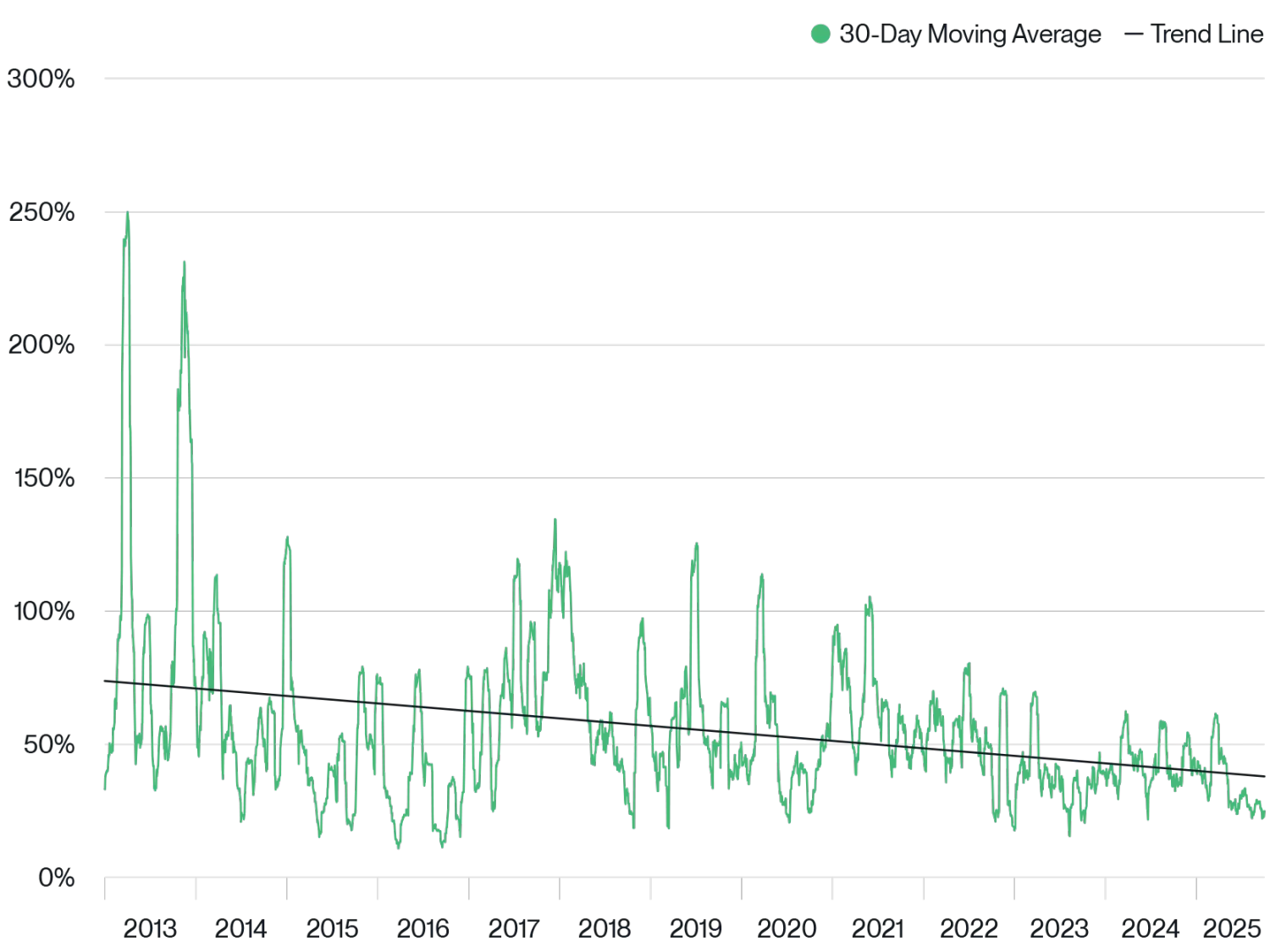Author: Matt Hougan, Chief Investment Officer of Bitwise
Translation: Saoirse, Foresight News
The sideways movement of Bitcoin marks the arrival of its "IPO moment." Why does this imply a higher proportion of asset allocation? The answer is as follows.
In Jordi Visser's latest article, a key question is explored: despite the continuous stream of positive news—strong ETF inflows, significant regulatory progress, and sustained institutional demand—Bitcoin's trading remains frustratingly stagnant.
Visser believes that Bitcoin is undergoing a "silent IPO," transforming from a "fantastical concept" into a "mainstream success story." He points out that typically, stocks experience a consolidation phase of 6 to 18 months during such a transformation before entering a bullish trend.
Take Facebook (now Meta) as an example. On May 12, 2012, Facebook went public at a price of $38 per share. For more than a year afterward, its stock price hovered in a sideways and downward trend, failing to break above the $38 IPO price for a full 15 months. Google and other high-profile tech startups exhibited similar patterns in their early trading days.
Visser states that sideways movement does not necessarily indicate a problem with the underlying asset itself. This situation often arises because founders and early employees choose to "cash out." Those investors who boldly bet on the startup when the risks were extremely high have now reaped returns of a hundredfold and naturally wish to secure their profits. The process of insiders selling and institutional investors stepping in takes time—only when this transfer of equity (or assets) reaches a certain balance will the price of the underlying asset reopen the upward channel.
Visser points out that Bitcoin's current situation is very similar to the above scenario. Those early believers who bought Bitcoin when its price was $1, $10, $100, or even $1,000 now hold wealth that can span generations. Bitcoin has now "entered the mainstream"—ETFs are trading on the New York Stock Exchange, large corporations are incorporating it into their reserve assets, and sovereign wealth funds are entering the market—these early investors finally have the opportunity to realize their gains.
This is worth celebrating! Their patience has finally paid off. Five years ago, if someone sold $1 billion worth of Bitcoin, it could have thrown the entire market into chaos; but now, the market has a sufficiently diverse buyer base and ample trading volume to absorb such large transactions more smoothly.
It should be noted that on-chain data interpretations of "who is selling" are not uniform, so Visser's analysis is just one of the factors currently influencing market trends. However, this factor is crucial, and contemplating its implications for the future market undoubtedly holds significant value.
Here are two core conclusions I have drawn from this article.
Conclusion One: Extremely Optimistic Long-Term Outlook
Many cryptocurrency investors felt disheartened after reading Visser's article: "The early big players are selling Bitcoin to institutions! Do they know something we don't?"
This interpretation is completely wrong.
The selling by early investors does not signify the "end of the asset's lifecycle"; it merely represents the asset entering a new phase.
Using Facebook as an example again. Indeed, its stock price traded below $38 for a year after the IPO, but today its stock price has reached $637, an increase of 1576% from the issue price. If I could go back to 2012, I would buy all Facebook shares at $38 each.
Of course, if one had invested during Facebook's Series A funding round, the returns might have been even higher—but the risks at that time were far greater than after the IPO.
The same applies to Bitcoin today. In the future, while the possibility of Bitcoin achieving hundredfold returns in a single year may decrease, once the "asset allocation phase" concludes, it still has significant room for growth. As Bitwise pointed out in its report on the "Long-Term Capital Market Assumptions for Bitcoin," we believe Bitcoin will reach $1.3 million per coin by 2035, and I personally think this prediction is still conservative.
Additionally, I want to add that the market for Bitcoin after early big players sell differs significantly from the market after a company's IPO. After a company completes its IPO, it still needs to sustain its stock price through continuous development—Facebook could not jump directly from $38 to $637 because it did not have sufficient revenue and profits to support such an increase; it had to gradually achieve growth through expanding revenue, exploring new businesses, and focusing on mobile, all of which still carried risks.
But Bitcoin is not like that. Once early big players complete their selling, Bitcoin does not need to "do anything"—to grow from its current $2.5 trillion market cap to gold's $25 trillion market cap, the only requirement is "to gain widespread recognition."
I am not saying this process will happen overnight, but it is likely to be faster than the price increase cycle of Facebook.
From a long-term perspective, Bitcoin's sideways movement is actually a "blessing in disguise." In my view, this is a good opportunity to accumulate more before Bitcoin restarts its upward trend.
Conclusion Two: The Era of 1% Bitcoin Allocation is Over
As Visser mentioned in the article, companies that have completed their IPOs carry far less risk than in the startup phase. Their equity distribution is broader, they face stricter regulatory scrutiny, and they have more opportunities for business diversification. Investing in post-IPO Facebook is far less risky than investing in a startup founded by college dropouts operating out of a party house in Palo Alto (the heart of Silicon Valley).
The current situation of Bitcoin is similar. As Bitcoin holders shift from "early enthusiasts" to "institutional investors," coupled with its technology maturing, Bitcoin no longer faces the "survival risks" it did a decade ago; it has become a mature asset class. This is clearly reflected in Bitcoin's volatility—since the Bitcoin ETF began trading in January 2024, its volatility has significantly decreased.
Historical Volatility of Bitcoin

Data source: Bitwise Asset Management. Data range: January 1, 2013, to September 30, 2025.
This change brings an important insight for investors: in the future, while Bitcoin's returns may slightly decline, its volatility will significantly decrease. As an asset allocator, in light of this change, my choice would not be to "sell"—after all, we predict that over the next decade, Bitcoin will be one of the best-performing major asset classes globally—instead, I would choose to "increase my holdings."
In other words, a decrease in volatility means "the risk of holding more of this asset is lower."
Visser's article also confirms a phenomenon we have long observed: over the past few months, Bitwise has held hundreds of meetings with financial advisors, institutions, and other professional investors, revealing a clear trend— the era of 1% Bitcoin allocation is over. More and more investors are beginning to believe that a 5% allocation should be the "starting point."
Bitcoin is experiencing its own "IPO moment." If history is any guide, we should embrace this new era by "increasing our holdings."
免责声明:本文章仅代表作者个人观点,不代表本平台的立场和观点。本文章仅供信息分享,不构成对任何人的任何投资建议。用户与作者之间的任何争议,与本平台无关。如网页中刊载的文章或图片涉及侵权,请提供相关的权利证明和身份证明发送邮件到support@aicoin.com,本平台相关工作人员将会进行核查。




